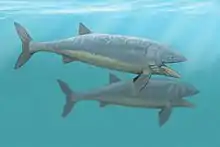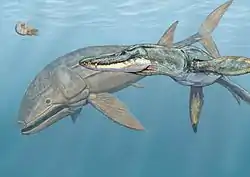利茲魚
困惑利茲魚(學名:)是利茲魚屬(學名:)的唯一物種及模式種;而這個屬是一種已經滅絕的巨大中生代輻鰭魚厚莖魚目的成員[1],生活在1億6500萬至1億5200萬年前的侏羅紀中晚期的海洋[2],直到白垩纪結束。牠們代表了真骨类的一個早期分支。
| 困惑利茲魚 化石时期:卡洛夫期至啟莫里期 ~165–152 Ma | |
|---|---|
 | |
| 現代人從利茲魚化石推想出來的想像圖 | |
| 科学分类 | |
| 界: | 动物界 Animalia |
| 门: | 脊索动物门 Chordata |
| 纲: | 辐鳍鱼纲 Actinopteri |
| 目: | †厚莖魚目 Pachycormiformes |
| 科: | †厚莖魚科 Pachycormidae |
| 属: | †利兹鱼属 Leedsichthys |
| 种: | †困惑利茲魚 L. problematicus |
| 二名法 | |
| Leedsichthys problematicus Woodward, 1889 | |
本物種首個被發現的遺骸在19世紀時被認出,被認為是有史以來最巨大的硬骨魚類。在現存魚類中與利茲魚最接近的是弓鰭魚,雖然這兩種魚類之間的關係仍然距離很遠。利茲魚的名稱意為「利茲的魚」,因化石收集家Alfred Nicholson Leeds於1889年在英格蘭彼得伯勒發現它的化石而得名[2]。 利茲魚的化石可以在英格蘭的卡洛夫階、德國及法國北部、智利的牛津階及法國的啟莫里階等地發現[3]。1999年,在智利的一次發現,學者一度以為發現了本屬的第二個物種,被曾將之命名為Leedsichthys notocetes,但事後發現這個「新物種」的遺骸無法與原有的遺骸分辨,所以認為這次發現的其實亦是原來的物種。
本屬物種的化石非常難以辨認及描述,因為牠們的化石非常破碎:其遺骸中有不少部分由軟骨組成,而這些軟骨均無法成為化石;而亦有多次這些碎片被錯誤辨認為剑龙亚目的恐龙遺骸。因此,利茲在發現它的化石後,以problematicus作為利茲魚的種小名[2]。
體型

雖然古生物學家已經發現幾具利茲魚的化石,但是完整的脊椎骨化石尚未發現[2],所以古生物學家很難確定牠的大小,亞瑟·史密斯·伍德沃德(Arthur Smith Woodward)在1889年描述利茲魚的標本,並拿牠的尾部與另一種厚莖魚類Hypsocormus比較後,估計它的長度大約是9公尺(30英呎)。古生物學家D. M. Martill在1986年拿他剛發現的利茲魚化石[4]與其他厚莖魚類互相比較,不過因為這具樣本相當不尋常[3],所以利茲魚推斷出來的體型大小範圍相當廣。最近古生物學家根據歷史上所發現的化石[5],及古生物學家在靠近彼得伯勒惠特西(Whittlesey)[6][7]所發現更完整的樣本來估計的結果都支持亞瑟史密斯伍德沃德當時所估計的結果-9至10公尺(30至33英呎)。近來古生物學家使用樹輪年代學來研究利茲魚的骨骸,結果顯示牠們要長到這個長度需要花費21至25年[8]。而根據其他樣本進行的研究顯示利茲魚最大可以長到超過16公尺[9](53英尺),從而推算出這種魚比現時的鯨鯊還要重的結論[10],是不合理的推論。
與現在最大的魚類鯨鯊及姥鯊一樣,利茲魚的食物來源是浮游動物,並且用牠的嘴與鰓從水中把浮游動物給過濾出來。保存在倫敦英國自然歷史博物館的P.6924樣本顯示,利茲魚遭受上龍亞目的滑齒龍攻擊。這些傷口後來癒合了,這顯示利茲魚可以躲避牛津黏土組(Oxford Clay)中的侏儸紀掠食者,很可能是因為牠們具有強大的尾巴。
注釋
- . 亚太日报. 2013-08-26 [2013-08-26]. (原始内容存档于2014-01-18).
- Liston, 2004
- Liston, 2008a
- Martill, 1986
- Liston & Noè, 2004
- Sloan, 2004
- Liston, 2006
- Liston, Steel & Challands, 2005
- Liston, 2005
- Barras, Colin. . 科學 (學術期刊). 2018-05-29 [2018-06-02]. doi:10.1126/science.aau3243 (英语).
參考資料
- "Biggest Fish Ever Found" Unearthed in U.K.页面存档备份,存于 National Geographic News. Published October 1, 2003.
- World's Largest Fish Fossil Found in England页面存档备份,存于. National Geographic News. Published October 3, 2003.
- . Most comprehensive overview of Leedsichthys, see further references within for further details.
- Haines, Tim & Chambers, Paul. (2006). The Complete Guide to Prehistoric Life. Canada: Firefly Books Ltd.
- Liston, JJ (2004). An overview of the pachycormiform Leedsichthys. In: Arratia G and Tintori A (eds) Mesozoic Fishes 3 - Systematics, Paleoenvironments and Biodiversity. Verlag Dr. Friedrich Pfeil, München, pp 379–390.
- Liston, JJ (2008a). Leedsichthys des Vaches Noires au peigne fin (translation by M-C Buchy) L’Écho des Falaises (=Ech.des Fal.) No.12: 41-49, 2008 ISSN 1253-6946.
- Liston, JJ (2008b). A review of the characters of the edentulous pachycormiforms Leedsichthys, Asthenocormus and Martillichthys nov. gen. In: Mesozoic Fishes 4 Homology and Phylogeny, G. Arratia, H.-P. Schultze & M. V. H. Wilson (eds.): pp. 181–198, 10 figs., 1 tab. © 2008 by Verlag Dr. Friedrich Pfeil, München, Germany – ISBN 978-3-89937-080-5.
- Liston, JJ & Noè, LF (2004). The tail of the Jurassic fish Leedsichthys problematicus (Osteichthyes: Actinopterygii) collected by Alfred Nicholson Leeds - an example of the importance of historical records in palaeontology. Archives of Natural History 31: 236-252.
- Sloan, C (2004). Big Fish Story. National Geographic Magazine, p.42. 1/9/2004.
- Liston, JJ (2006). From Glasgow to the Star Pit and Stuttgart: A short journey around the world's longest fish. The Glasgow Naturalist 24: 59-71.
- Liston, JJ, Steel, L & Challands, TJ (2005). Lured by the Rings: Growth structures in Leedsichthys. In: Poyato-Ariza FJ (ed) Fourth International Meeting on Mesozoic Fishes - Systematics, Homology and Nomenclature, Extended Abstracts. Servicio de Publicaciones de la Universidad Autónoma de Madrid/UAM Ediciones, Madrid, pp 147–149.
- Liston, JJ (2005). Homologies amongst the fragments: searching for synapomorphies in shattered skulls. In: Poyato-Ariza FJ (ed) Fourth International Meeting on Mesozoic Fishes - Systematics, Homology and Nomenclature, Extended Abstracts. Servicio de Publicaciones de la Universidad Autónoma de Madrid/UAM Ediciones, Madrid, pp 141–145.
- Smith Woodward, A (1889). Preliminary notes on some new and little-known British Jurassic fishes. Geological Magazine Decade 3 Volume 6: 448-455.
- Smith Woodward, A (1905). A Guide to the Fossil Reptiles, Amphibians, and Fishes in the Department of Geology and Palaeontology of the British Museum (Natural History). Eighth edition. British Museum (Natural History), London. Pp xviii, 110 pages.
- Martill, DM (1986). The world's largest fish. Geology Today March-April: 61-63.
外部連結
- For more on the Star Pit dig of 2002-2003 look here 页面存档备份,存于
- the BBC-Open University series Fossil Detectives. 页面存档备份,存于
- For a more accurate reconstruction of Leedsichthys visit Paleocreations.页面存档备份,存于
- The profile of Leedsichthys problematicus from the BBC series Sea Monsters 页面存档备份,存于
- "Biggest Fish Ever Found" Unearthed in U.K.页面存档备份,存于 國家地理新聞,於2003年10月1日發布
- An article on the latest discovery of a Leedsichthys problematicus fossil页面存档备份,存于估計72英尺(22)長
- A picture of Leedsichthys problematicus
- An article on Leedsichthys from Darren Nash

